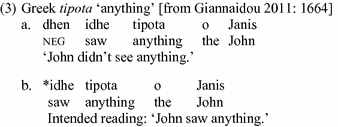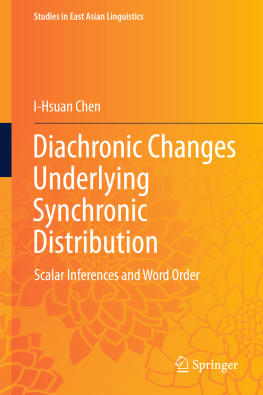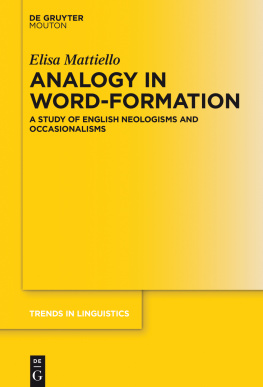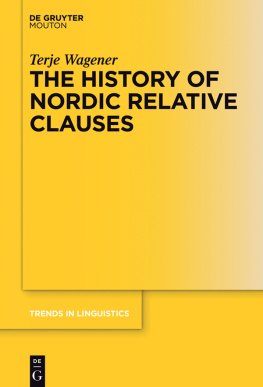1. Introduction
This study deals with synchronic variation through a diachronic lens. Mismatches between syntactic and semantic properties are usually rooted in diachronic development. This study addresses this layer of synchronic-diachronic association through the analysis of how numeral phrases referring to a small quantity have developed as polarity sensitive items in Mandarin Chinese. The analysis will show how a polysemy network has developed by being associated with semantically and syntactically relevant constructions. In order to capture the tendencies of language change, a longitudinal corpus study is conducted to examine how constructions have developed internally and how that development has been conditioned by linguistic factors external to the constructions in question.
The linguistic phenomenon concerned in the diachronic study is the development of Mandarin Chinese one-phrases, which have three components: the numeral one, the unit word, and a noun. One-phrases have a special status in East Asian numeral classifier languages, such as Mandarin Chinese, Japanese, and Korean due to their multiple functions. Although the basic function of one-phrases is to count or to measure, they are often recruited for a wider range of purposes, such as to serve as an indefinite referential expression, as an attenuator, and as a polarity sensitive item for pragmatic enhancement. The concept of one can be shaped into different functions when it is profiled against different scale settings. Among these functions, a particular focus is placed on the function of polarity items because one-phrases as polarity items exhibit various kinds of distributional variation across different periods of Chinese. The skewed distribution of one-phrases as polarity items in different word order patterns is conditioned by multiple related factors, such as specificity, quantification, scalarity, negation, and focus. The study aims to incorporate these factors from a diachronic perspective with an account of how the synchronic variation of one-phrases reflects a series of syntactic and semantic changes in the history of Chinese.
The following subsections will introduce the linguistic issues and phenomena concerned in this study. When one-phrases are used as negative polarity items (NPIs), they belong to the category of minimizers. The syntactic distribution of NPIs has received considerable attention from linguists due to its restrictive occurring conditions. The issues regarding the syntactic constraints and the properties of minimizers are summarized in Sect. offers an overview of the characteristics of numeral phrases in numeral classifier languages, and how one-phrases are used for a wide array of functions.
The analysis of the diachronic development of one-phrases as polarity items in this study is based on a constructional approach. The constructional analysis of incremental changes is discussed in Sect. provides a summary of the topics covered in each chapter and of the research questions regarding the one-phrases as minimizers.
1.1 Licensing of NPIs and Types of NPIs
Polarity phenomena, such as positive polarity items (PPIs) and negative polarity items (NPIs), have been cross-linguistically observed. According to Haspelmath (1997)s typological survey of indefinites, NPIs are common in languages. They are famous for their exclusion from positive assertions with simple past (Giannakidou 2011), as exemplified by English any , French rien anything ( rem thing), and Greek tipota anything. The examples in (13) show that these elements cause ungrammaticality in affirmative environments but go well with negation.



This specific constraint has directed linguists attention to the issue of NPI licensing. Since Klimas (1964) analysis of English negation, NPI licensing has received great attention in English in crosslinguistic studies. Studies on NPIs started with a focus on negation, since negation has been considered a typical condition required for NPIs. Therefore, NPIs are claimed to be licensed or triggered by negation (Ladusaw 1980). However, NPIs can also be licensed in other conditions, such as conditionals and questions. The issue of how to delimit a coherent category characterizing the environments has become a central one in NPI studies. The licensing requirements of NPIs arouse the debate regarding their grammatical representation and their relations to the constraints on polarity items. The syntactic, semantic, and pragmatic approaches to the sanction of NPIs will be briefly summarized in this section.
1.1.1 Syntactic Perspectives
Syntactically, the concept of licensing is generally translated as structural constraints. This approach manifests the relation between polarity items and their licensors in a structural representation. Specifically, negation is regarded as the primary licensor, and NPIs must be within the scope of negation. An overt or covert c-command relation is often used to account for the scope relation. The treatment of negation as the primary licensor in this approach captures the fact that negation is a prototypical licensor and that certain types of NPIs are legitimate only under negation. However, the assumption also implies that non-negative licensors receive less coverage in this approach.
The licensing condition is an interesting topic in generative approaches because it exhibits a strong structural dependency. In the generative framework, the licensing condition can be formulated at the level of logical form (LF), at the level of S-structure, or at both levels (Linebarger 1980; Progovac 1994; Uribe-Etxebarria 1994). Since negation is the primary licensor, non-negative conditions often resort to additional mechanisms (Baker 1970) or an overt operator (Progovac 1994). For example, the principle of Binding Theory is applied to the licensing conditions by Progovac (1994). NPIs have to be bound to negation or other functional operators in their governing category, as in (4).

The null operator is posited to account for the non-negative licensing conditions in terms of the locality relations between NPIs and their licensors. Besides the narrow focus on syntactic dependency, the scope relation between NPIs and their licensors is another important topic in this approach. For instance, Linebarger (1987) proposes a scope constraint, stating that NPIs are acceptable in a sentence S if in the LF of S the NPIs are in the immediate scope of the negation operator. The scope constraint successfully explains the licensing of negation, but non-negative licensors, such as adversative predicates doubt, be surprised , as in (5), need a secondary mechanism. The NPI lift a finger in (5) is licensed although the sentence has no negator.















